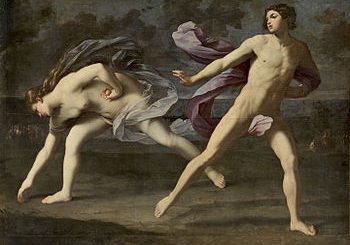Atalanta’s garland: Mansfield and the study of poverty by Sude A.
Atalanta’s garland is a book published by the Edinburgh University Women’s Union in 1926 to celebrate its twenty-first anniversary. When I first saw it, I thought it was remarkable how modern and professional the book looked. I was expecting something like a 1920s-style college magazine, but the book was obviously of high quality and contained enough works for me to think of it as an anthology instead after my first perusal. In terms of quality, what I noticed first was the abundance of artwork present in the book; these were definitely impressive and left an impression that Atalanta’s garland was a labor of love for all of the women involved in its publishing.
This is a first edition copy; tucked into the cover is a 1951 listing of secondhand books and periodicals pricing it at $12.50. It is interesting to note that this House of Books listing chooses to display Atalanta’s garland as primarily Katherine Mansfield’s work, as it features her “Two Unpublished Sketches.” Yet when I turned the page and read the prefatory note, Mansfield was not mentioned at all. The prefatory note mainly discussed the women’s union’s history and acknowledged “all the writers, both English and foreign, who have given so generously of their work” (vii). Mansfield’s work was definitely not the focus of the book more so than any of the other authors. Based on the prefatory note, she is situated in a conversation on women’s work and contributions to society through increasing access to educational facilities.
“But more elegant than all such figures is the actual work which they are doing in the world today. In Education, in welfare work, in the Civil Service…”
Clearly, Atalanta’s garland values above all women who have pushed forward women’s roles in society in some way, and thus has an inherently feminist and political pretext. Mansfield and her fellow writers and illustrators are a representation of the contribution of women to society in the literary and artistic sense. Later on, according to the listing as well as our own resources, it became a book most well-known for hosting Mansfield’s work. It brings great questions of her fame in relation to the other authors, as well as the value of reading a work in its original context. Had I not read “Two Unpublished Sketches” in the original book, I would have assumed that Atalanta’s garland was solely focused on presenting Katherine Mansfield’s work.
The works themselves stand in contrast to “The Garden Party,” easily one of Mansfield’s most recognizable works. “The Garden Party” is told in a traditional narrative format; Laura, the central character, is a young girl from a wealthy family. While “The Garden Party” begins in media res with Laura preparing to host a party for her fellow socialites, this mundane veneer is soon lifted. When a working-class neighbor dies in an accident, she insists on bringing the family leftovers from the party and comes into contact with the impoverished neighbors for the first time; she experiences revelations about class divisions, mortality, and the way these two concepts play a role in her own life. In terms of style, both of the “Sketches” are written almost as observational journal entries or field study notes by a third party. The two pieces are titled I. Little Jean and II. Lucien, the names of the children in question; the overall impression is almost clinical and detached. “The Garden Party” is a longer work in a narrative format with the main character as the narrator. “The Garden Party” is explicit about class divides and presents the perspective of someone who is deeply entrenched in bourgeois decadence and cannot comprehend the destitution of her poor neighbors. Little Jean and Lucien are also from an outsider’s perspective: one of a clinical observer. The class backgrounds of these children are not approached as explicitly as class in “The Garden Party.” The reader must pick up on hints about the children’s lives; Jean’s “cheeks were white because he lived in a basement” (3). The constant anxiety about his health situation in relation to his living conditions clearly indicates that the family is from an impoverished background. Lucien’s mother is a dressmaker who is constantly belittled and degraded by her clients : “the big, blowsy peasant women who came to his mother’s room… shout[ed] at his mother” (6). Her clients are only peasants, and if they belittle Lucien’s mother too, she must be of an even lower social rank. The works approach the topic of life in poverty in parallel manners: they are both told by observers who maintain a mixture of distance and sympathy.












Recent Comments